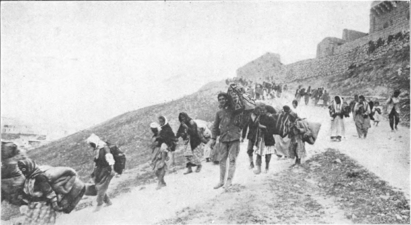The Gruesome Details; Thousands of Cultural Leaders Killed
An Armenian Day of Mourning
Special to The Great War Project
(23-24 April) On April 24th one hundred years ago to the day, the head of the Armenian Church in the Ottoman Empire appeals to U.S. President Woodrow Wilson to intervene in the slaughter of Turkey’s Armenian population. Wilson does not respond.

Of this photo, the US ambassador wrote “Scenes like this were common all over the Armenian provinces in the spring and summer months of 1915. Death in its several forms.”
It is a day when the systematic murder of Armenians is spreading rapidly. Tens of thousands are now forced out of the eastern Turkish town of Erzurum and into the mountains and desert of Mesopotamia (now Iraq).
It is the day when the Ottoman War Minister Enver Pasha issues deportation orders, according to historian Sean McMeekin, “that the Armenian population in problem areas must be reduced to less than ten percent.”
The murder of Armenians is so terrible that even Germany, ally of the Ottomans, is embarrassed.
“In Constantinople,” writes historian Martin Gilbert, “the German ambassador went to the Turkish Foreign Ministry and expressed his hope that anything that ‘might look like Christian massacres’ would be avoided. He was told that the Turkish garrison in the Province of Van [where deportations are savagely underway] consisted of poorly trained conscripts and that ‘excesses’ might not be entirely avoidable.”
“The killings continued.”
And evidence emerges that the massacres cannot be attributed solely to “excesses.”
On this day a century ago, the Ottoman authorities arrest and deport 250 Armenian cultural leaders in Constantinople. “We now see,” reports writer Peter Balakian, “how well planned and orchestrated the whole scheme was.”
According to Balakian, “We also recognize the importance that the [Ottoman government] placed on killing the intellectuals, first in Constantinople, then throughout the country.”
“Thousands of cultural leaders were killed.”
Balakian gives an all-too-vivid picture of how the killing is done. “The perpetrators often used the tools of the farmer, butcher, and tanner – axes, hoes, meat cleavers, pitchforks, knives, and gouges – to kill and mutilate.”
The methods of the atrocities are even more gruesome.
Deportation and relocation “was merely a charade.”
The leaders of the Armenian community declare this day the Armenian Day of Mourning. Later the word genocide will be used to characterize the Ottoman annihilation of the Armenians.
Historian Eugene Rogan makes the observation that there is a bitter irony in this episode of the First World War. The massacre of the Armenians – allegedly carried out in order to safeguard the national security of the Ottoman Empire — in no way fulfills that goal.
“The extermination of Armenian communities in eastern Anatolia [Turkey] did nothing to protect the Caucasus from Russian invasion” as Turkish leaders claim it was intended to do.
“The deportations,” writes Rogan, “actually undermined the Ottoman war effort.

